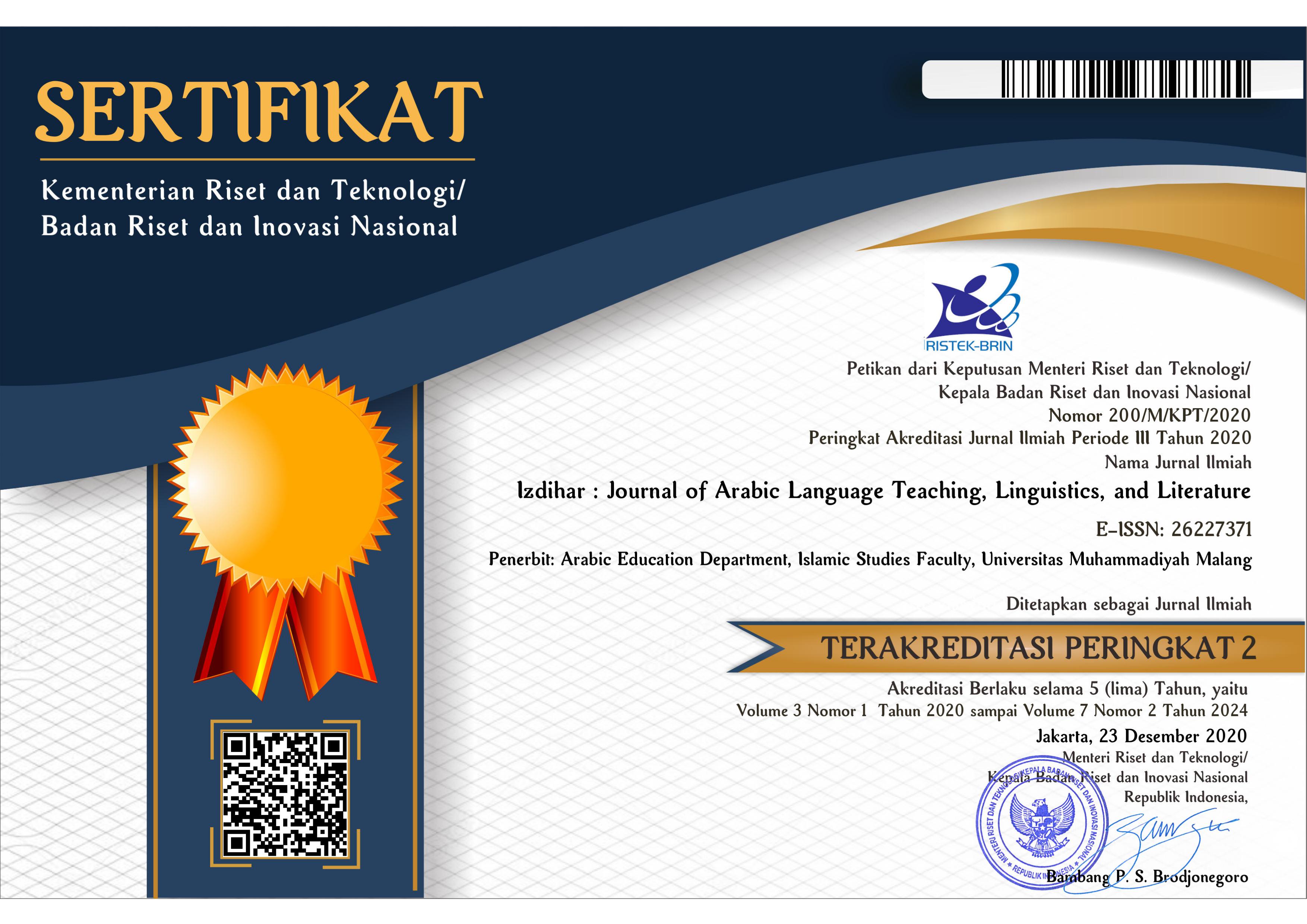The Influence of Using Audio-lingual Method on Students’ Speaking Skill in Madrasah Diniyah Takmiliyah Awwaliyyah
DOI:
https://doi.org/10.22219/jiz.v3i2.12514Keywords:
Arabic Language, Learning, Speaking SkillAbstract
The study aimed to determine the influence of audio-lingual methods towards the Arabic speaking skills, the method used in this research was quantitative with experimental quasi approach, data collection technique was polling and test. The population of this research was 102 students in the MDTA Bustanul Huda at Padang City, West Sumatera, Indonesia. Data obtained through polls and tests were then analyzed statistically. The analysis used the normality test, homogeneity test, and hypothesis test. All three types of tests were done with the help of the SPSS Statistics 22 program. The results of the study were: 1) the use of audio-lingual methods was categorized on good classification with an average of 63.33 in intervals 62-64; 2) Speaking Arabic skills was categorized on good classification with an average of 68 in intervals 65-68; and 3) the score of influence with N 30 obtained sig α 0.001 and the score of r Square 0.35. There was a significant influence between the use of audio-lingual methods to the Arabic speaking skill of students at MDTA Bustanul Huda Ulak Karang at Padang City Indonesia in the academic year 2019/2020. The influence of variable X to variable Y because students are accustomed to hearing how to speak Arabic as the native speaker of the Arabic language.
Downloads
References
Abu-Melhim, A.-R. (2009). Re-evaluating the Effectiveness of the Audio-lingual Method in Teaching English to Speakers of Other Languages. International Forum of Teaching and Studies, 5(2), 39–45. ISSN:1555-872X
Bidenko, L., & Bespalova, G. (2017). Implementing Audio-Lingual Method to Teaching Ukrainian AS A Foreign Language At The Initial Stage. Advanced Education, 7, 23–27. DOI: https://doi.org/10.20535/2410-8286.82711
Effendy, A. F. (2009). Metodologi Pengajaran Bahasa Arab. Bandung:Misykat.
Hanani, N. (2018). al-Thariqah al-Sam’iyyah al-Syafahiyyah fi Ta’lim al-Lughah al-’Arabiyyah wa Tatbiquha. Asalibuna, 2(2), 1–13. DOI: https://doi.org/10.30762/asa.v2i2.1132
Hasyim, S. (2015). al-Thariqah al-sam’iyyah al-Syafahiyyah wa Tathbiquha ’ala Tadris al-Kalam. Lisanuna, 4(2), 236–250. DOI: https://doi.org/10.30762/asa.v2i2.1132
Hermawan, A. (2011). Metodologi Pembelajaran Bahasa Arab (Issue 1). Bandung: PT Remaja Rosda Karya.
Iskandarwassid, & Suhendra, D. (2009). Strategi Pembelajaran Bahasa (Issue 2). Bandung: PT Remaja Rosda Karya.
Janah, M., & Nashoih, A. K. (2019). Effectiveness of Al-Thariqah Al-Intiqaiyyah in Improving Arabic Learning Outcomes for Islamic Senior High School Students. Izdihar: Journal of Arabic Language Teaching, Linguistics, and Literature, 2(3), 201–216. DOI: https://doi.org/10.22219/jiz.v2i3.10108
Maaliah, E., Widodo, Y. H., & Aziz, M. (2016). Using Audio-Lingual Method to Improve the Student’s Speaking Skill (A Classroom Actian Research at the Fifth Grade of Madigondo Elementary School in the Academic Year of 2015/2016). Jurnal Bahasa Inggris Terapan, 3(1), 45–59.DOI: https://doi.org/10.35313/inggris.v3i1
Mart, C. T. (2018). The Audio-Lingual Method : An Easy way of Achieving Speech. International Journal of Academic Research in Business and Social Sciences, 3(12), 10–13. DOI: https://doi.org/10.6007/IJARBSS/v3-i12/412
Maspalah. (2015). Metode Audio-lingual dalam Pembelajaran Bahasa Arab untuk Meningkatkan Kemampuan Berbicara. Jurnal Pendidikan Bahasa Dan Sastra UPI, 15(1), 68–78. https://media.neliti.com/media/publications/119433-ID-metode-audio-lingual-dalam-pembelajaran-b.pdf
Mei, S. Y., Ju, S. Y., & Mohd, A. B. (2017). Cooperative Learning Strategy in Teaching Arabic for Non Native Speakers. European Journal of Social Sciences Education and Research, 11(2), 262–267. DOI: https://doi.org/10.26417/ejser.v11i2.p261-266
Mei, Y. (2018). Comments on the Audio-lingual Method. International Journal of Arts and Commerce, 7(4), 47–53. https://ijac.org.uk/images/frontImages/gallery/Vol.7No.4/5.47-53.pdf
Meyad, N. A., Roslan, S., Abdullah, M. C., & HajiMaming, P. (2014). The Effect of Differentiated Learning Method in Teaching Arabic Language on Students’ Motivation. Journal of Social Science Research, 5(8), 671–678. DOI: https://doi.org/10.24297/jssr.v5i1.6651
Nikmah, K. (2020). Interrogative Sentence: A Contrastive Study of Arabic and Indonesian. Izdihar: Journal of Arabic Language Teaching, Linguistics, and Literature, 2(3), 183–200. DOI: https://doi.org/10.22219/jiz.v2i3.10148
Pace, F. A. (1972). The Bases in Pragmatism of the Audio-Lingual Method of Teaching Modern Languages. Michigan: University Microfilms.
Rachmawati, M., Nugrahaeni, F., & Mauludiyah, L. (2020). Improving Arabic Speaking Skill through Mind Mapping Strategy. Izdihar: Journal of Arabic Language Teaching, Linguistics, and Literature, 3(1), 31–44. DOI: https://doi.org/10.22219/jiz.v3i1.10967
Rahmawati, N. (2019). Pengaruh Media Audio Visual terhadap Pemahaman Maharoh Istima’ Bahasa Arab. IQ (Ilmu Al-Qur’an): Jurnal Pendidikan Islam, 2(02), 217–231. DOI: https://doi.org/10.37542/iq.v2i02.34
Ramadhah, H. I., Ghabban, M. I., ’Umsyah, K. H. A., Isma’ili, Y., ’Ali, S., Al-Qawasimiyyah, W., Syu’ban, M., Al-Syaikh, M. A., Bu’atur, T., Mukhtari, F., & Bulbake, J. (2018). Ma’ayir Maharat al-Lughah al-’Arabiyyah Linnathiqina bi Ghairiha (Issue 1). https://www.academia.edu/36665119/كتاب_معايير_مهارات_اللغة_العربية_للناطقين_بغيرها_أبحاث_محكمة
Ramadhan, H. I. (2017). Ta’lim al-’Arabiyyah li Ghayr al-Nathiqina biha Ru’yah Istisyrafiyyah (Issue 1). Mansyurat al-Muntadi al-’Araby al-Turkey.
Ritonga, M., Alrasi, F., & Bambang. (2018). Dirasah Tahliliyah ’an Ahammiyah Ma’rifah al-Tashrif fi Fahmi al-Lughah al-’Arabiyyah. Arabiyatuna: Jurnal Bahasa Arab, 2(1), 23–34. DOI: http://dx.doi.org/10.29240/jba.v2i1.333
Rozi, F. (2017). Musykilat Ta’lim al-Mufradat al-’Arabiyyah Linnathiqina bi Ghairiha wa Iqtirahat Lihalliha. Jurnal Ummul Qura, 9(1), 42–55. http://ejournal.kopertais4.or.id/pantura/index.php/qura/article/view/3038
Samah, R., Puteh-behak, F., Saad, N. S. M., Ali, S. M., Darmi, R., & Harun, H. (2016). Effective Methods in Learning Arabic Language as a Foreign Language. Mediterranean Journal of Social Science, 7(3), 349–355. DOI: https://doi.org/10.5901/mjss.2016.v7n3p349
Sartika, F., & Ritonga, M. (2020). Ta’tsir Isti’mal al-Wasa’il al-Sam’iyyah al-Bashariyyah “Ala Nataij Ta’lim Mufradat al-Lughah al-’Arabiyyah Lilfashl al-Rabi” fi al-Madrasah al-Ibtida’iyah al-Islamiyyah al-Hukumiyyah Parambahan Lambasi Payakumbuh. Alfazuna, 4(2), 144–154. DOI: https://doi.org/10.15642/alfazuna.v4i02.592
Sbai, M. A., & Ouakrime, M. (2016). Teaching the Speaking Skill through The Audio-lingual Method. https://www.academia.edu/21774215/Teaching_the_Speaking_Skill_through_The_Audio_lingual_Method
Susanti, E., Ritonga, M., & Bambang, B. (2020). Pengaruh Penggunaan Media Powerpoint Terhadap Minat Belajar Bahasa Arab Siswa. Arabiyatuna: Jurnal Bahasa Arab, 4(1), 179–191. DOI: https://doi.org/10.29240/jba.v4i1.1406
Syakur, N. (2010). Revolusi Metodologi Pembelajaran Bahasa Arab dari Pendekatan Komunikatif ke Komunikatif Kambiun. Yogyakarta: Pedagogia.
Taufiq, A. (2018). Dafi’iyah Istikhdam at-Ta’allum at-Ta’awuni Litanmiyyah Ta’lim Maharah al-Kalam. Jurnal Izdihar: Journal of Arabic Language Teaching, Linguistics, and Literature, 1(1), 79–104. DOI: https://doi.org/10.22219/izdihar.v1i1.6564
Thu’aimah, R. A. (2004). al-Maharat al-Lughawiyyah Mustawiyatuha Tadrisuha Shu’ubatuha (Issue 1). Cairo: Dar al-Fikr al-’Araby.
Wahab, M. A. (2015). Pembelajaran Bahasa Arab di Era Posmetode. Arabiyat: Jurnal Pendidikan Bahasa Arab Dan Kebahasaaraban [Online], 2(1), 59–74. DOI: https://doi.org/10.15408/a.v2i1.1519
Wargadinata, W., Maimunah, I., Febriani, S. R., & Humaira, L. (2020). Mediated Arabic Language Learning for Arabic Students of Higher Education in COVID-19 Situation. Izdihar: Journal of Arabic Language Teaching, Linguistics, and Literature, 3(1), 59–78. DOI: https://doi.org/10.22219/jiz.v3i1.11862
Zahro, U. C., Amalia, S. R., & Amin, N. F. (2020). The Effectiveness of Direct Method in Arabic Language Learning. Jurnal Al Bayan; Jurnal Jurusan Pendidikan Arab, 12(1), 149–164. DOI: https://doi.org/10.24042/albayan.v12i1.5775
Downloads
Published
How to Cite
Issue
Section
License
Copyright Notice
Authors who publish with this journal agree to the following terms:
- Authors retain copyright and grant the journal right of first publication with the work simultaneously licensed under a Creative Commons Attribution-ShareAlike 4.0 International License that allows others to share the work with an acknowledgment of the work's authorship and initial publication in this journal.
- Authors are able to enter into separate, additional contractual arrangements for the non-exclusive distribution of the journal's published version of the work (e.g., post it to an institutional repository or publish it in a book), with an acknowledgment of its initial publication in this journal.
- Authors are permitted and encouraged to post their work online (e.g., in institutional repositories or on their website) prior to and during the submission process, as it can lead to productive exchanges, as well as earlier and greater citation of published work (See The Effect of Open Access).
Copyright (c) 2019 Izdihar : Journal of Arabic Language Teaching, Linguistics, and Literature

This work is licensed under a Creative Commons Attribution-ShareAlike 4.0 International License.

















